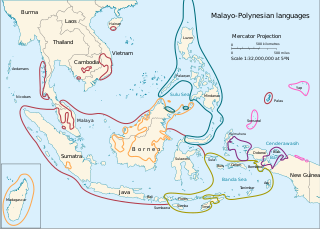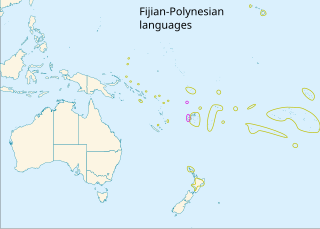
The Malayo-Polynesian languages are a subgroup of the Austronesian languages, with approximately 385.5 million speakers. The Malayo-Polynesian languages are spoken by the Austronesian peoples outside of Taiwan, in the island nations of Southeast Asia and the Pacific Ocean, with a smaller number in continental Asia in the areas near the Malay Peninsula, with Cambodia, Vietnam and the Chinese island Hainan as the northwest geographic outlier. Malagasy, spoken in the island of Madagascar off the eastern coast of Africa in the Indian Ocean, is the furthest western outlier.

The approximately 450 Oceanic languages are a branch of the Austronesian languages. The area occupied by speakers of these languages includes Polynesia, as well as much of Melanesia and Micronesia. Though covering a vast area, Oceanic languages are spoken by only two million people. The largest individual Oceanic languages are Eastern Fijian with over 600,000 speakers, and Samoan with an estimated 400,000 speakers. The Gilbertese (Kiribati), Tongan, Tahitian, Māori and Tolai languages each have over 100,000 speakers. The common ancestor which is reconstructed for this group of languages is called Proto-Oceanic.

The Central Pacific languages, also known as Fijian–Polynesian languages, are a branch of the Oceanic languages spoken in Fiji and Polynesia.

The Western Oceanic languages is a linkage of Oceanic languages, proposed and studied by Ross (1988). They make up a majority of the Austronesian languages spoken in New Guinea.
The Meso-Melanesian languages are a linkage of Oceanic languages spoken in the large Melanesian islands of New Ireland and the Solomon Islands east of New Guinea. Bali is one of the most conservative languages.
The North New Guinea languages of Papua New Guinea and Indonesia form a possible linkage of Western Oceanic languages. They have been in heavy contact with Papuan languages.
The Ngero–Vitiaz languages form a linkage of Austronesian languages in northern Papua New Guinea. They are spoken, from west to east, in Madang Province, Morobe Province, and New Britain.
The Central–Eastern Malayo-Polynesian (CEMP) languages form a proposed branch of the Malayo-Polynesian languages consisting of over 700 languages.

The Papuan Tip languages are a branch of the Western Oceanic languages consisting of 60 languages.
The Schouten languages are a linkage of Austronesian languages in northern Papua New Guinea. They are in contact with various North Papuan languages, particularly the Skou and some Torricelli languages.
The Huon Gulf languages are Western Oceanic languages spoken primarily in Morobe Province of Papua New Guinea. They may form a group of the North New Guinea languages, perhaps within the Ngero–Vitiaz branch of that family.
Sulka is a language isolate of New Britain, Papua New Guinea. In 1991, there were 2,500 speakers in eastern Pomio District, East New Britain Province. Villages include Guma in East Pomio Rural LLG. With such a low population of speakers, this language is considered to be endangered. Sulka speakers had originally migrated to East New Britain from New Ireland.

The Southern Oceanic languages are a linkage of Oceanic languages spoken in Vanuatu and New Caledonia. It was proposed by John Lynch in 1995 and supported by later studies. It appears to be a linkage rather than a language family with a clearly defined internal nested structure.
In historical linguistics, a linkage is a network of related dialects or languages that formed from a gradual diffusion and differentiation of a proto-language.

Western Pantar, sometimes referred to by the name of one of its dialects, Lamma, is a Papuan language spoken in the western part of Pantar island in the Alor archipelago of Indonesia. Western Pantar is spoken widely in the region by about 10,000 speakers. Although speakers often use Malay in political, religious, and educational contexts, Western Pantar remains the first language of children of the region, and is acquired to some extent by immigrants.
The family of Northwest Solomonic languages is a branch of the Oceanic languages. It includes the Austronesian languages of Bougainville and Buka in Papua New Guinea, and of Choiseul, New Georgia, and Santa Isabel in Solomon Islands.
Basap is an Austronesian language spoken in Borneo, Indonesia.
The Niwer Mil language is spoken by 9,033 people on Boang Island, Malendok Island, Lif Island and Tefa Island in the Tanga Islands, Namatanai District of New Ireland Province in Papua New Guinea. It was split from the Tangga language in 2013. It is one of the languages that form the St George linkage group of Meso-Melanesian languages.
The Malakula languages are a group of Central Vanuatu languages spoken on Malakula Island in central Vanuatu. Unlike some earlier classifications, linguist and Oceanic languages specialist John Lynch (2016) considered the Malakula languages to form a coherent group.
The Torres–Banks languages form a linkage of Southern Oceanic languages spoken in the Torres Islands and Banks Islands of northern Vanuatu.




